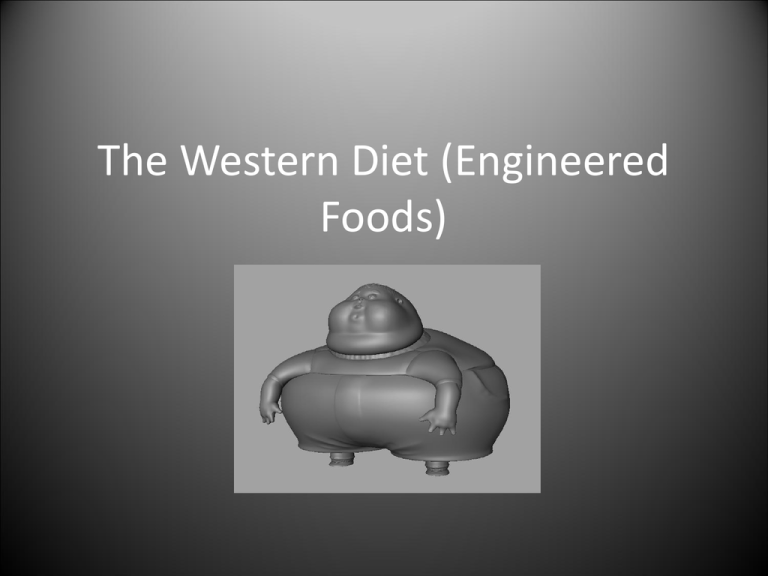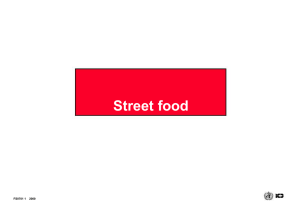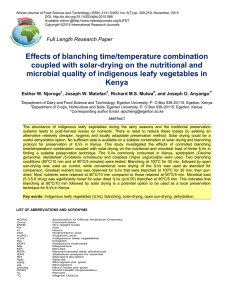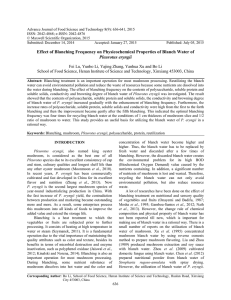The Western Diet
advertisement

The Western Diet (Engineered Foods) Why Do We Process Foods? How Do We Process Foods? Evolution Evolutionary Discordance Where did the Western Diet Start? • 10 000 years ago • Introduction of agriculture and Food Engineering • Introduction of animal husbandry New Food Stuff • 70% of our daily energy intake was unavailable prior to the industrial revolution – Refined sugar – Refined vegetable oil – Cereals – Diary products – Alcohol – Mixed foods, Canned Foods, Frozen Foods • Cookies, pizza, soft drinks, ice cream...etc!!!! Lets Look at Unit Operations and Consequences? • Simplest Unit Operation – Size Reduction – Increased Functionality i.e., starch from granule – Increased shelf life i.e. sugar from sugar cane – Used as ingredients i.e., vegetable oils Milling • Separate the endosperm from the bran and germ Brown Rice White Rice % REMOVED Dietary Fiber 3.32 g 0.74 g Vitamin E 1.4 mg 0.462 mg 72.2 mg 22.6 mg 10 mcg 4.1 mcg Thiamin (B1) 0.223 mg 0.176 mg Riboflavin (B2) 0.039 mg 0.021 mg Niacin (B3) 2.730 mg 2.050 mg Vitamin B6 0.294 mg 0.103 mg 26 mg 19 mg Magnesium Folacin Selenium 78% 67% 69% 59% 21% 46% 14% 69% 27% 3.5% of our energy is from whole grains 20.4% of our energy is from refined grains Refined Sugar • • • • • • Crystalline sugar 500BC Pre 500BC honey was consumed Typical consumption <1kg per capita Post industrial revolution 6.8kg per capita Currently 69kg per capita Now there is high fructose corn syrups and other artificial sweeteners Refined Sugars • Average American consumes 2-3 pounds of sugar each week • One of sugar's major drawbacks is that it raises the insulin level, which in turn depresses the immune system. – This is not something you want to take place if you want to avoid disease. Refined vegetable oils • From 1909 to 1999 • 130% increase in the consumption of salad and cooking oils • 140% increase in the consumption of shortening • 410% increase in the consumption of margarine 2nd Unit Operation -- Hydrogenation • Produce what was thought to be novel trans fatty acid isomers • Trans elaidic acid only occurs in hydrogenated food stuff • One of the food industries largest mistakes. Butter Vs. Margarine? Most Common Unit Operation Thermal Processing • Commonly applied during food processing • Severity of the process (amount of heat applied) is a function of both time and temperature – This minimizes nutrient loss – Minimizes reduction in product quality – Minimizes energy consumption Thermal Processing • Most widely applied unit operation in food processing • Fundamental aspects – Involves the application of heat – Amount of heat added is a function of time and temperature – Preservative effects largely due to denaturation of protein Types of Thermal Processing • • • • Cooking Blanching Pasteurization Sterilization Cooking • Primary objective: to increase palatability – Baking, roasting - dry heat, 150-200°C – Boiling, stewing, steaming - boiling water to steam (~100°C) – Frying with or without oil, 175 to 225°C • Some preservative changes – Destruction of some spoilage and all pathogenic microorganisms – Inactivation of deteriorative enzymes – Reduction of water Cooking • Other desirable changes – Inactivation of some antinutritional factors • avidin in egg white which binds biotin (B7) • hemagglutinins in kidney and wax beans – agglutination of red blood cells • Improved digestibility of some food constituents Cooking • Undesirable changes – Loss of nutrients • Oxidation of unsaturated lipids • Degradation of antioxidants – Decline in sensory quality with excessive heating • Non enzymatic Browning—toast and maple syrup Nutrient Loss • Lysine bio -availability reduced by nonenzymatic browning • Heat sensitive vitamins—decreases bioavailability not concentration – Vitamin A, Carotenes, Vitamin D • Water leaching vitamins-decreases concentration not bioavailability – Thiamine, Niacin, Folate, Blanching • Prior to drying of fruits • Primary objective – Inactivate deteriorative enzymes – Also kills some spoilage bacteria (reduces microbial load) • Commercially – Atmospheric steam or boiling water (~100°C) – Pressurized steam or hot gas (>100°C) • Less severe process than canning for example Water Vs Steam Blanching Water Vs Steam Blanching • Steam blanching has little to no leaching of nutrients Blanching • Blanching prior to freezing • Blanching of vegetables prior to canning – Removes tissue gases – Cleanses tissue, wilts tissue • Blanching of fruits before drying – Surface pasteurization to extend shelf life – Drying conditions may not destroy enzymes Blanching • Losses mainly due to: leaching, thermal destruction, oxidation • Amount of losses depend on: – Type of food – Extent of particle size reduction – Ratio of surface area to volume – Time / temp – Heating and cooling medium • Leaching greater in water than steam or air – Ratio water to food Pasteurization • A heat treatment which kills part of the microbial population present in a food – Min changes in sensory or nutritive value • Pasteurization of milk – Primary objective is to kill pathogenic microorganisms; shelf life is extended due to a reduction in spoilage organisms, deteriorative enzymes – Target pathogens: was Mycobacterium tuberculosis (TB), now Coxiella burnetti (Q fever) Mycobacterium tuberculosis • Are found in infected cattle worldwide. • These organisms are destroyed by pasteurization. • Cause tuberculosis, a lung disease. • Tuberculosis in the US is not very common today, although historically milk was a common source of tuberculosis. Coxiella burnetii • The prevalence of Coxiella burnetii was >94% in raw milk samples from the Northeastern, Midwestern, and Western regions of the US tested between 2001 and 2003 Pasteurization • Two equivalent processes in terms of microbial kill • LTH (low temp, hold) = 63°C for 30 min • HTST (hi temp, short time or flash) = 72°C for 15 sec • However, LTH is more detrimental to nutritional and sensory properties • Don’t drink raw milk – Other pathogens - Ontario study (1997) Listeria monocytogenes, salmonella, Verotoxogenic E. coli. Pasteurization • Beer – Intention to kill spoilage organismsprimarily wild yeasts, gives a shelf life of 6 months for bottled beer vs 1 month for draft • Juices • Eggs - recommended that pasteurized eggs be used for salad dressings and sauces to kill salmonella – Can now do “in shell” Sterilization • A heat treatment sufficient to destroy ALL microorganisms capable of growth under the conditions of storage – This is not true sterility as some nonpathogenic spore forming bacteria may eventually grow under optimum conditions • Severity of the process required for safety and shelf stability is dependent on the acidity of the food product being canned. • Low-acid foods (pH > 4.5) • Acid foods (pH 3.7 to 4.5) • High-acid foods (pH < 3.7) Low Acid Foods (pH 4.5) • Most severe process is needed for low-acid foods – Clostridium botulinum will grow and produce toxin in foods at pH 4.6 or greater – Spore-forming, obligate anaerobe, ubiquitous • Canning of low acid foods (pH > 4.5) – meats, fish, vegetables, mixed entrees, most soups – Need to process at 121°C for ~15 min. – How do we get water to boil at 121°C rather than 100°C? High Acid Foods (pH 4.5) • Fruit jams, fruit cocktail, tomatoes*** and tomato juice***, peaches, vegetable juice – Primary target - facultative anaerobes (Bacillus spp). – Can use milder process • do not need to pressure can, can process at 100°C • Must make sure tomatoes are acidic enough • Boiling water bath at atmospheric pressure is sufficient High Acid Foods • Apple juice, cider, berries, citric juices, sour pickles, sauerkraut – Targets are yeast and molds – Anaerobic bacteria won’t grow, so can use a milder process for spores of yeasts and molds. • Can “hot fill” containers at ~90°C • Should also invert to heat the lid, volume change on cooling will create slight vacuum Factors Influencing Severity • Severity of thermal process required to produce commercial sterility depends on: – Nature and heat resistance of the microbes present – Initial microbial load – Nature of the food (e.g. pH, chemical composition, water activity…) – Conditions of storage First Order Kinetics • Most biological inactivation processes (e.g., enzyme denaturation, microbial death, spore deactivation) are a function of both time and temperature • Effect of Time: usually follows first-order kinetics: Thermal Resistance • Death rate of microorganisms is logarithmic • In a given time interval, at a constant temperature, the same proportion of a microbial population will be destroyed Pasteurization: • 7 log kill for Salmonella in Milk = 99.99999% Temperature: 145°F (63C) 161°F (72C) 212°F (100C) 280°F (131C) Time: 30 min 15 sec 0.01sec 6 sec • Pasteurization of eggs: 3 log reduction = 99.9% 145°F for 3 to 4 mins. • Fruit juices are pasteurized to reduce microbial count and inactivate enzymes; they were thought not to carry pathogens. Log Numbers Time (min) 1 2 3 4 5 6 7 8 9 10 # survivors 1,000,000 100,000 10,000 1,000 100 10 1 0.1 0.01 0.001 Log # survivors 6 5 4 3 2 1 0 -1 -2 -3 Log vs linear Why Do We Use HTST vs LTLT Processing Mild vs. Severe Heat Treatment: Mild Heat Treatment): Severe Heat Treatment: •Aims: •Kill pathogens •Reduces bacterial load (Food is not sterile) •Inactivate enzymes •Advantages: •Minimal damage to flavor, texture, and nutritional quality. •Disadvantages: •Short shelf life •Another preservation method must be used, such as refrigeration or freezing •Examples: •Pasteurization •Blanching •Aims: •Kills all bacteria •Food will be commercially sterile •Advantages: •Long shelf life •No other preservation method is necessary •Disadvantages: •Food is over-cooked •Major changes in texture, flavor, and quality •Examples: •Canning Unit Operations • Almost all unit operations reduce quality – Milling – Evaporation – Cooking – Pasteurization – Irradiation • However we see benefits – Convenience, supply and demand, microbial safety, Food for Thought Western countries single largest cause of morbidity and mortality are diet-related chronic diseases!!!! Food for Thought 50-65% of the western adult population are afflicted with a diet related disease. Food for Thought Food related disease do not steam from a single element of food consumption, but rather from a complex interaction of multiple nutritional factors. Evolution








